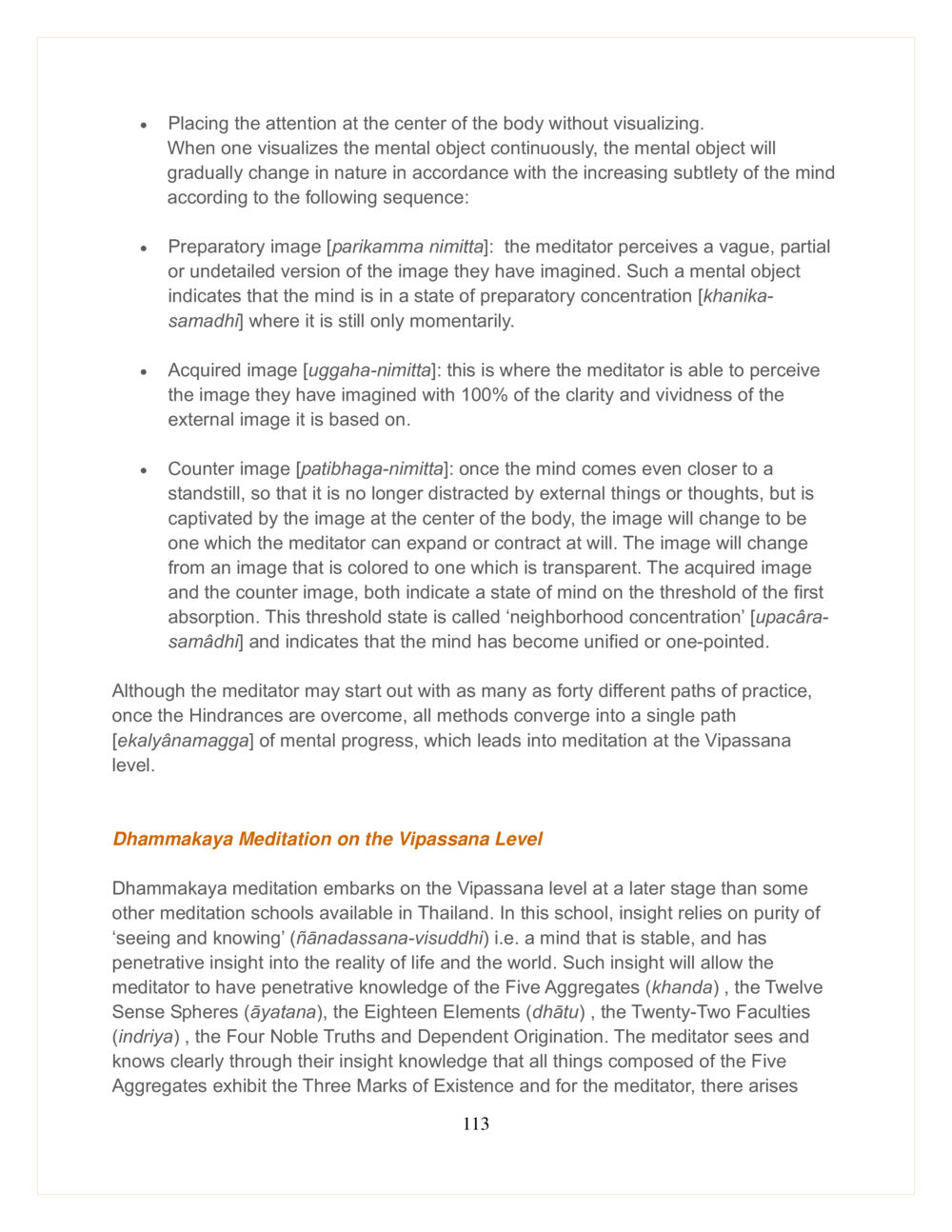Understanding Dhammakaya Meditation and Mental Progress : หน้า 113/115
DMC Translor’s handbook : หน้า 113/115 Explore the stages of Dhammakaya meditation and its journey towards insight and unity of mind for a profound meditative experience.
5 ครั้ง

สรุปเนื้อหา
การทำสมาธิแบบธรรมกายมุ่งเน้นไปที่การวางจิตใจ ณ ศูนย์กลางของร่างกายโดยไม่ต้องมองเห็นภาพภายนอก การตั้งใจภาพที่แท้จริงนำไปสู่การให้ความชัดเจนในจิต เพราะเมื่อจิตอยู่ในสภาวะสงบจะเกิดภาพที่สามารถขยายหรือหรือลดขนาดได้ นอกจากนี้ ทางการปฏิบัติในธรรมกายจะมาถึงการเห็นและรู้ที่บริสุทธิ์ในความเป็นจริง ซึ่งช่วยให้นักปฏิบัติเข้าใจองค์ประกอบต่างๆ ของชีวิตและโลกรอบตัว เช่น สี่อริยสัจ เป็นต้น ความรู้ที่เกิดขึ้นจะทำให้ผู้ปฏิบัติเห็นว่าทุกสิ่งที่เกี่ยวข้องกับธาตุทั้งห้าล้วนมีลักษณะสามประการของการมีอยู่
หัวข้อประเด็น
-Dhammakaya Meditation
-Vipassana Level
-Stages of Mental Objects
-Preparatory Image
-Acquired Image
-Counter Image
-Insight Knowledge
-Unity of Mind
-Five Aggregates
ข้อความต้นฉบับในหน้า
- Placing the attention at the center of the body without visualizing. When one visualizes the mental object continuously, the mental object will gradually change in nature in accordance with the increasing subtlety of the mind according to the following sequence:
- Preparatory image [parikamma nimitta]: the meditator perceives a vague, partial or undetailed version of the image they have imagined. Such a mental object indicates that the mind is in a state of preparatory concentration [khanika-samadhi] where it is still only momentarily.
- Acquired image [uggaha-nimitta]: this is where the meditator is able to perceive the image they have imagined with 100% of the clarity and vividness of the external image it is based on.
- Counter image [patibhaga-nimitta]: once the mind comes even closer to a standstill, so that it is no longer distracted by external things or thoughts, but is captivated by the image at the center of the body, the image will change to be one which the meditator can expand or contract at will. The image will change from an image that is colored to one which is transparent. The acquired image and the counter image, both indicate a state of mind on the threshold of the first absorption. This threshold state is called ‘neighborhood concentration’ [upacara-samadhī] and indicates that the mind has become unified or one-pointed.
Although the meditator may start out with as many as forty different paths of practice, once the Hindrances are overcome, all methods converge into a single path [ekalyānamagga] of mental progress, which leads into meditation at the Vipassana level.
*Dhammakaya Meditation on the Vipassana Level*
Dhammakaya meditation embarks on the Vipassana level at a later stage than some other meditation schools available in Thailand. In this school, insight relies on purity of ‘seeing and knowing’ (nānadassa-visuddhi) i.e., a mind that is stable, and has penetrative insight into the reality of life and the world. Such insight will allow the meditator to have penetrative knowledge of the Five Aggregates (khandas), the Twelve Sense Spheres (ayatanas), the Eighteen Elements (dhātu), the Twenty-Two Faculties (indriya), the Four Noble Truths and Dependent Origination. The meditator sees and knows clearly through their insight knowledge that all things composed of the Five Aggregates exhibit the Three Marks of Existence and for the meditator, there arises
หน้าหนังสือทั้งหมด
หนังสือที่เกี่ยวข้อง
Load More



















































































































